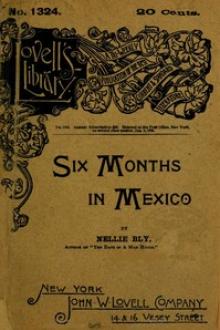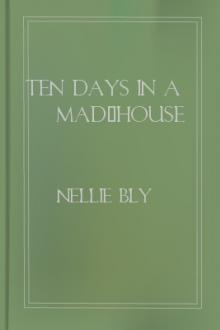Six Months in Mexico by Nellie Bly (best classic literature TXT) 📕

- Author: Nellie Bly
- Performer: -
Book online «Six Months in Mexico by Nellie Bly (best classic literature TXT) 📕». Author Nellie Bly
Cocoanut dulce: - Grate fine two cocoanuts. Put in a dish three pounds of sugar, let boil, take off the scum, then add the cocoanut, stirring all the time. After a little a bowl of cream, then later eighteen eggs, well beaten. Let cook, stirring constantly, until, when you pass the spoon through the middle of the mixture, you can see the bottom of the dish; then take off. Put in platters. Peel and cut almonds in half; put them in as thickly as you please. Pass over it a hot iron until nicely smoothed.
Pineapple and sweet-potato dulce: - Grate pineapple, and boil sweet potatoes, half and half. For one pineapple two pounds of sugar; let boil and skim. Put in and boil, stirring all the time, until you can see the bottom of the pan as the spoon passes through the center.
Rice and almonds: - One ounce of grated almonds, one ounce of rice washed and ground; put in enough milk so it will pass through a cloth; put tins in a quart of milk, with three yokes of eggs and sugar to taste; boil until well done; flavor to taste.
SOME MEXICAN LEGENDS.
THERE is hardly a spot in Mexico that has not some romantic history connected with it; and the tales are always so beautiful and full of thrilling romance. I would like to live in Mexico some time, and devote all my attention to gathering these interesting stories. I have given samples of them in the history of Don Juan Manuel.
The Street of the Jewel is also connected with a story full of love and its companion, despair. Here dwelled Gasper Villareal and his wife, Violante Armejo. Gasper was a man of moderate means, but he had enough to preserve his wife from labor. She was of wondrous beauty but quite strange, she only cared to hide herself in her convent-like home. She loved her husband, and he was as jealous as a Mexican can be.
One day a young noble. Diego de Fajardo, rode by the door, and, being thirsty, he asked the mozo for a drink. Violante sat in the corridor, looking upon the garden, and dreaming, doubtless, of her absent lord. True to the instincts of her race, she ordered the mozo to take the stranger a glass of wine. The servant did her bidding, explaining to the young cavalier the reason of the change in his refreshments. Diego de Fajardo felt that it would be churlish to ride away without acknowledging the gracious hospitality. He tossed his bridle to the man and passed into the garden.
Violante still sat in her hammock, garbed in spotless white, the perfection of beauty, grace and innocence. The young caballero had not uttered his thanks until he had vowed to win Gasper Villareal’s lovely wife.
Day after day he watched the casa, waiting for an opportunity to find the wife alone. At last fate favored him. It was near nightfall when he saw the husband come forth, and, taking saddle, ride toward the city. In a moment, eager and confident, he fell on his knees before Violante and confessed his love.
She did not full into his arms, but she spurned him and with such anger that he saw his conduct in its true light, and, repentant he arose from his knees and left her. Violante started to her chamber to seek her rosary and to cool her throbbing brow with the touch of holy water, when her foot struck a sparkling object; it was a bracelet, With her name, “Violante,” in diamonds, close beside the coronet and arms of De Fajardo.
As she stood her husband entered. Having to return for something, he had been struck with horror to see a man rush from his gateway. There stood his wife with the jewel in her hand, the evidence of her guilt. Without a word he sunk his dagger in her breast. As she sank lifeless to the floor, he snatched the gleaming bracelet from her stiffening fingers and left the house.
Diego de Fajardo was wakened in the morning by his mozo. Something had happened and he was wanted to go out in the street to see if he could understand it. Tremblingly he obeyed. On the pavement, Gasper Villareal lay rigid, his garments soaked with his life’s blood. Near the bronze knocker of the massive door was a splendid diamond bracelet, suspended on a blood-stained dagger.
In 1550 the lake of Texcoco overflowed, and almost submerged the City of Mexico. Among the objects found drifting upon the water was a large canvas, on which appeared a beautiful representation of the Virgin. None could determine where it came from, so a chapel was built for it. It is called “Our Lady of the Angels.” For centuries it has received the veneration of man.
Another inundation occurred in 1607, and all the chapel, except the side holding the Virgin’s picture, was washed away. Despite all the storms the picture was said to be as bright as if just from the painter’s brush. A new chapel was built around this marvelous painting, which stood until 1627, when another flood took it all away excepting the one wall holding the Virgin’s likeness. There, neglected and unprotected, it stood as the storms had left it until 1745, when a succession of public calamities drove the people to implore the succor of the Virgin. A building was again erected around the uninjured painting. Thus, until the present day, the people in need seek the painting to pour forth their prayers at its feet.
El Desierto and its old Carmelite convent occupy the most charming spot in Mexico. It is only fifteen miles from the capital, and the way is along the most romantic and picturesque road a Southern clime can produce. The forest that surrounds El Desierto is composed of the largest trees in the valley, hardly excepting those of Chapultepec. The convent was a group of massive buildings, domes and turrets, now crumbling into decay. In 1625 the monks retreated to this wilderness to mortify the flesh, and strange stories of their serio-jovial life, their sparkling wines and romance of their hermit-like existence come creeping down through centuries; the jolly monks are no more, and the winds sigh through the mighty forest that has ridden romance, love and tragedy from the world.
The conqueror, Cortez, not satisfied with robbing the grand old Aztec king, Montezuma, of his land and life, also robbed him of his daughter. The poor woman, after he deserted her, died in a convent, leaving a daughter, the child of Cortez. This daughter of Cortez, and granddaughter of Montezuma, was married very young to a Spanish captain, Quinteros. There are now in Puebla descendants of that illegal love.
CHAPTER XXXVII.
PRINCESS JOSEFA DE YTURBIDE.
I CANNOT close this little book without speaking of one of the most remarkable and brilliant women in Mexico, the only daughter of the emperor. After the execution of the emperor the family came to the States, and settled in Philadelphia. Josefa was sent to Georgetown to receive an English education, and she yet retains a love for America and its people. When Maximilian entered Mexico he restored the titles to the Yturbide family, and invited the cultured princess to become a member of his imperial household. Subsequently Emperor Maximilian adopted Augustin Yturbide, grandson of the late emperor, and appointed the Princess Josefa guardian of the “prince imperial.” Maximilian soon recognized the wonderful executive abilities of the princess, and he consulted her on momentous occasions. Had he taken her advice, I doubt not but that Mexico would have had an empire to-day.
After the fall of Maximilian, Mrs. Yturbide (formerly Alice Green, of Washington, D. C.) claimed and recovered her son, who had been temporarily “heir presumptive” to the throne of Mexico. The Princess Josefa went to the court of Austria. Nine years ago she returned to Mexico, where she lives in seclusion.
She is one of the loveliest women, in every respect, I ever met. Her rooms at the Hotel Humboldt are plain, but contain many little mementos of former glory. The pictures and busts of the unfortunate emperor and empress occupy prominent positions.
“Carlotta was only twenty-three years old when she came to Mexico,” said the princess. “She was a beautiful girl, with a creamy complexion, dark eyes and hair. She worshiped her young husband, as he did her, and she was ambitious for his sake. What a sad fate was theirs!”
The princess then showed me five letters she had received from Carlotta, written in English, after the emperor’s death; they gave no evidence of her insanity. The princess has never received any recompense for the land which the government took from her father, and even a pension due her, which now amounts to some hundred thousands, has never been paid. She receives many promises from Diaz but never the money.
The worst things the Mexicans ever did for themselves was to shoot Maximilian. They have never had one quarter so good government since. They had sworn good faith to the emperor and said if he sent part of the French army back they would support him. He believed them, and when he found that they were dishonest he applied to Napoleon for aid. When he received no answer, the empress, eager to save her noble husband, started to beg Napoleon personally for help, much against the wish of Maximilian.
The republican powers getting too strong for the emperor, some advised him to seek refuge until things grew calmer. The refuge he sought was the prison they had prepared for him. He walked into it, and he never came forth until the day he was shot. His bosom friend, Lopez, whom the emperor had enriched, had made a general, and intrusted him with all his secrets, betrayed him to his enemies. On June, 19, 1867, Maximilian and his brave comrades, Miramon and Mejia, were led forth to a little hilt near Queretaro and shot. Maximilian’s last words were: “Poor Carlotta.’” Three little black crosses now mark the spot where those noble men died.





Comments (0)